How Long Does Baileys Last After Opened
When properly stored in the refrigerator, your opened bottle of Baileys Irish Cream will maintain its best quality for up to 6 months, though it remains safe to consume for up to 2 years. You'll want to keep it in its original bottle with a tightly sealed cap at a temperature between 32°F and 45°F. While room temperature storage is acceptable for short periods below 68°F, refrigeration greatly extends the liqueur's shelf life. Watch for signs of spoilage like separation, unusual odors, or texture changes that resemble cottage cheese. Proper storage techniques can help you maximize your Baileys' longevity and enjoyment.
This post may contain affiliate links. If you make a purchase through these links, I may earn a commission at no additional cost to you. Additionally, portions of this post may be generated using artificial intelligence (AI) technology. While we strive for accuracy, please be aware that AI-generated content may not always be perfect and should be fact-checked when necessary.
The Spatula Scoops
- Opened Baileys can last up to 2 years when properly refrigerated, though best quality is maintained within the first 6 months.
- Store opened Baileys in the refrigerator at 32°F – 45°F (0°C – 7°C) with a tightly sealed cap to maximize shelf life.
- At room temperature, opened Baileys lasts about 6 months maximum, with quality declining noticeably after 2 months.
- Check for spoilage signs including separation, darkening color, lumpy texture, or sour smell before consuming opened Baileys.
- Baileys left at extreme temperatures or exposed to direct sunlight will deteriorate faster, potentially lasting only 2 months.
The Basics of Baileys Storage
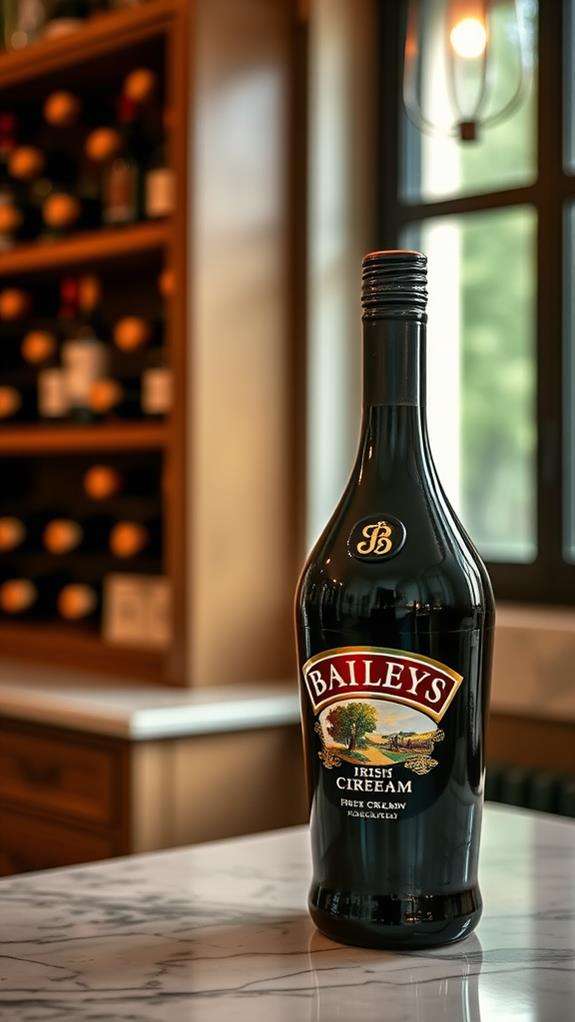
While Baileys Irish Cream contains alcohol, its dairy content means you'll need to store it properly once opened. The cream liqueur requires specific storage conditions to maintain its quality and prevent spoilage, even with its 17% alcohol content serving as a natural preservative.
You'll want to keep your opened bottle of Baileys in a cool, dark place, with the refrigerator being your best option. The ideal storage temperature ranges between 32°F and 45°F (0-7°C). When you're storing the bottle, make sure it's tightly sealed to prevent oxidation and keep unwanted odors from affecting the taste. You shouldn't store Baileys in areas that experience temperature fluctuations, like near your stove or in a cabinet above your refrigerator.
If you're planning to store your Baileys outside the fridge, choose a location that maintains a consistent temperature below 68°F (20°C). The pantry or liquor cabinet can work, but refrigeration will extend the shelf life considerably. Remember to always check that the cap is secured properly after each use, as exposure to air accelerates degradation of the cream components.
Official Shelf Life Guidelines

According to Baileys' manufacturer, an opened bottle remains safe to drink for about 2 years when stored properly in the refrigerator. You'll need to monitor several key indicators to guarantee your bottle stays within these guidelines, including appearance, smell, and texture.
Here's a breakdown of Baileys' shelf life indicators at different stages:
| Storage Time | Appearance | Safety Status |
|---|---|---|
| 0-6 months | Smooth, consistent | Ideal quality |
| 6-12 months | Slight separation possible | Safe to consume |
| 12-24 months | May show thickness changes | Check before consuming |
While the manufacturer's guidelines suggest 24 months, you'll want to inspect your bottle regularly for signs of spoilage. If you notice any curdling, separation that won't remix, or an off-putting smell, it's best to discard the bottle regardless of the timeline. The cream liqueur contains preservatives that help maintain its quality, but these become less effective once the bottle's seal is broken. You should always check the "best by" date printed on the bottle, as this serves as your initial reference point for the two-year countdown after opening.
Signs of Spoiled Baileys
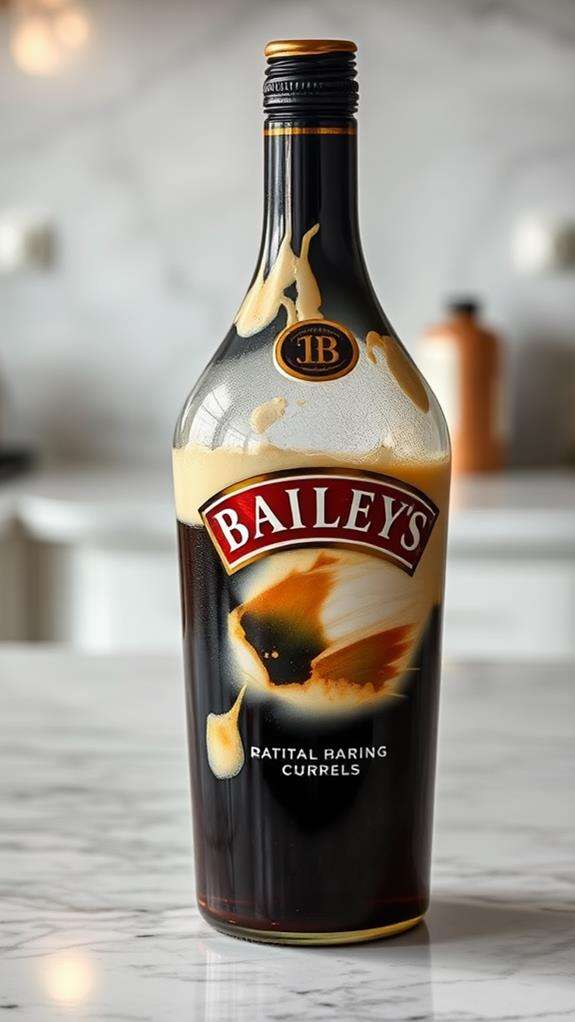
When checking if your Baileys has gone bad, you'll want to look out for three main warning signs that indicate spoilage. The first red flag is any change in color from creamy beige to a darker brown or any separation in texture, while the second indicator is an off-putting, sour smell that's distinctly different from the Irish cream's typical sweet aroma. Finally, watch for any clumping or curdling in the liquid, which often appears as small, solid chunks floating in the bottle or a grainy, uneven consistency that wasn't there when you first opened it.
Color Changes and Texture
Fresh Baileys Irish Cream maintains a consistent creamy beige color and smooth texture throughout its shelf life. When you notice any changes to these characteristics, it's often a sign that the liqueur has begun to deteriorate. You'll want to examine your Baileys carefully before each use, looking for any separation, curdling, or color variations.
If you observe that your Baileys has darkened noticeably or developed a yellowish tinge, it's likely beginning to spoil. The texture should remain silky and uniform; when it starts to become grainy, lumpy, or shows signs of separation, you shouldn't consume it. You'll also notice that spoiled Baileys won't pour smoothly and may form small chunks or clumps as it moves.
Watch for any layering in the bottle, which indicates the cream has separated from the whiskey base. While slight separation can sometimes be fixed by gentle shaking, if you see distinct layers that won't remix or notice the formation of butter-like solids, your Baileys has definitely gone bad. The texture should never be sticky, gummy, or resemble cottage cheese, as these are clear indicators of spoilage.
Unusual Smell and Flavor
Your nose and taste buds serve as reliable indicators of spoiled Baileys Irish Cream. When you notice any off-putting aromas that deviate from the liqueur's signature sweet, creamy scent, it's time to be cautious. Fresh Baileys should smell like a balanced blend of Irish whiskey, cream, and chocolate, but if you detect sour notes, a curdled milk odor, or anything resembling spoiled dairy, don't consume it.
The taste test, while not recommended if you suspect spoilage, can reveal telling signs. If your Baileys has developed a sharp, bitter, or unpleasantly sour flavor, it's likely gone bad. You might also notice a significant departure from its characteristic smooth, velvety taste. The alcohol content should mask any overwhelming dairy notes, so if you're getting strong milk-like flavors, that's another red flag. Sometimes, you'll detect a chemical or artificial taste that wasn't present when you first opened the bottle – this indicates chemical changes have occurred within the liqueur. If you're experiencing any of these unusual flavor profiles or questionable smells, it's best to discard the bottle rather than risk consuming spoiled cream liqueur.
Clumps and Curdling Signs
One of the most obvious signs of spoiled Baileys Irish Cream is the formation of clumps or curdling within the bottle. When you notice any lumps, floating solids, or a grainy texture, it's a clear indication that the cream has separated and the alcohol content can no longer keep it properly emulsified.
You'll want to examine your Baileys by gently swirling the bottle and checking for any inconsistencies in texture. If you spot small lumps that don't dissolve with gentle agitation, or if the liquid appears separated into distinct layers, don't consume it. The curdling process occurs when the cream component begins breaking down, often due to exposure to heat, light, or simply time. You might notice that the texture becomes thicker in some areas while remaining thin in others, creating an uneven consistency throughout the bottle.
When pouring the liqueur into a glass, pay attention to how it flows. Fresh Baileys should pour smoothly and evenly, while spoiled Baileys may come out in uneven spurts or with visible chunks. If you're seeing any of these signs, it's best to discard the bottle.
Proper Storage Methods
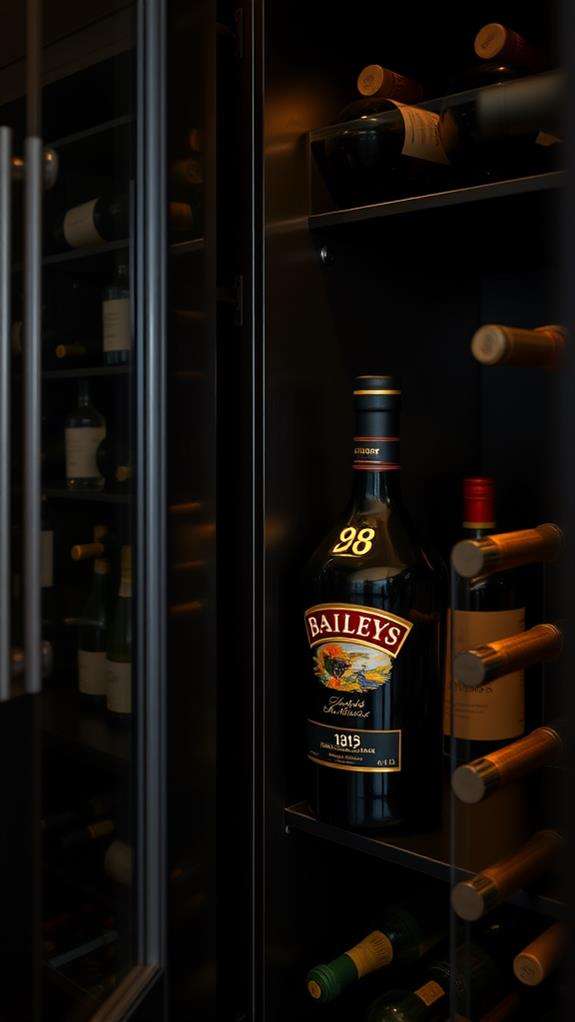
To keep your opened bottle of Baileys fresh for as long as possible, you'll need to follow specific storage guidelines that balance temperature and container integrity. When storing Baileys in the refrigerator, maintain a consistent temperature between 32-41°F (0-5°C), and guarantee the cap is tightly sealed after each use to prevent oxidation and maintain the cream's stability. Whether you choose refrigeration or room temperature storage (though refrigeration is preferred), always keep your Baileys in its original bottle with its airtight seal intact, away from direct sunlight and heat sources, and positioned upright to minimize the liquid's contact with the cap.
Refrigeration Requirements and Tips
Proper refrigeration stands as the golden rule for preserving opened Baileys Irish Cream. You'll want to keep your bottle at a consistent temperature between 32-41°F (0-5°C), which is the standard refrigerator range that helps maintain the cream's stability and prevents separation of ingredients.
When you're storing your opened Baileys, you shouldn't place it in the refrigerator door, as this area experiences the most temperature fluctuation. Instead, position the bottle on a middle shelf toward the back, where the temperature remains more stable. You'll need to verify the cap is tightly sealed after each use to prevent oxidation and maintain freshness.
If you notice your Baileys has been left out at room temperature for several hours, don't panic – it's still safe to refrigerate and consume, provided it hasn't been exposed to extreme heat. However, you shouldn't make this a habit, as repeated temperature changes can affect the liqueur's quality. For best preservation, try to return the bottle to the refrigerator within 30 minutes of each use, and always check for any unusual thickening, separation, or off-putting odors before consumption.
Room Temperature Storage Guidelines
Keeping Baileys at room temperature requires careful attention to storage conditions. While storing your opened bottle of Baileys in the refrigerator is perfect, you can keep it at room temperature for short periods if you follow specific guidelines. The bottle should be stored in a cool, dry place away from direct sunlight and heat sources, with temperatures staying between 65-75°F (18-24°C).
You'll need to verify the bottle's cap is tightly sealed after each use to prevent oxidation and contamination. Don't leave the bottle near windows, stoves, or other heat-producing appliances, as temperature fluctuations can accelerate degradation. If you're storing Baileys in a cabinet, choose one that's not above or adjacent to your oven or dishwasher.
The maximum time you should keep Baileys at room temperature is about two weeks, even with prime storage conditions. You'll notice quality changes through visual and olfactory cues: if the cream starts separating, the color becomes darker, or you detect any sour or off-putting aromas, it's time to discard the bottle. Always check for these signs before consuming, regardless of how long you've stored it.
Airtight Container Best Practices
Successful storage of Baileys Irish Cream starts with selecting the right airtight container when you can't use the original bottle. You'll want to choose a container that's both practical and effective at preserving the cream liqueur's quality and preventing oxidation.
| Container Type | Best Features | Drawbacks |
|---|---|---|
| Glass Bottles | Doesn't absorb odors, Easy to clean | Can be heavy, Breakable |
| Plastic Containers | Lightweight, Durable | May absorb flavors, Can degrade |
| Metal Flasks | Temperature stable, Durable | Can't see contents, Possible metallic taste |
| Vacuum-Sealed | Best preservation, Longest shelf life | More expensive, Complex to use |
When transferring your Baileys, make certain you're working with clean containers that have been thoroughly dried. You'll need to check that the seal is functioning properly by conducting a simple leak test with water before use. If you're using a screw-top container, make sure the threads are intact and the lid tightens completely. Remember to minimize the amount of air space at the top of your container, as this reduces oxidation and helps maintain the cream liqueur's smooth texture.
Temperature and Environmental Factors
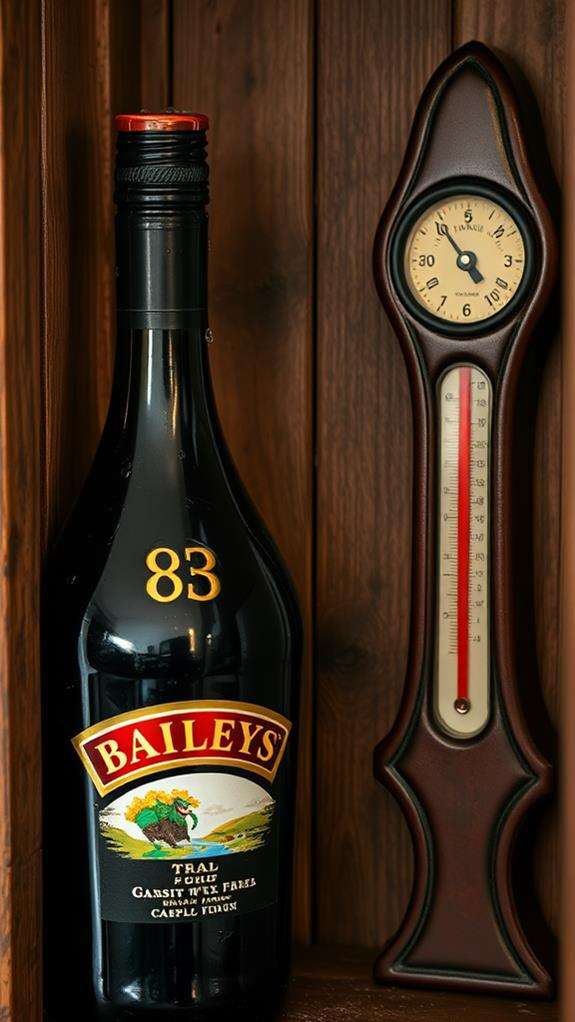
Temperature and storage conditions play an essential role in how long your opened Baileys will last. You'll want to keep your bottle in a cool, dark place away from direct sunlight and heat sources, as these environmental factors can greatly impact the cream liqueur's quality. The ideal storage temperature ranges between 32°F and 77°F (0°C to 25°C), though you'll get the best results keeping it closer to refrigeration temperature.
- Avoid storing your Baileys near windows, as UV rays can cause chemical reactions that alter the taste and texture
- Keep the bottle away from heating vents, stoves, or other heat-producing appliances that could warm the liqueur
- Don't let your Baileys experience frequent temperature fluctuations, which can cause the cream to separate
- Consider storing the bottle in your refrigerator, especially if your home tends to be warm
While Baileys contains preservatives that help maintain its shelf life, proper temperature control remains vital. If you notice your bottle has been exposed to excessive heat or temperature changes, check for signs of separation, curdling, or unusual thickness before consuming. Remember that even brief exposure to extreme temperatures can accelerate the degradation process.
Best Drinking Window
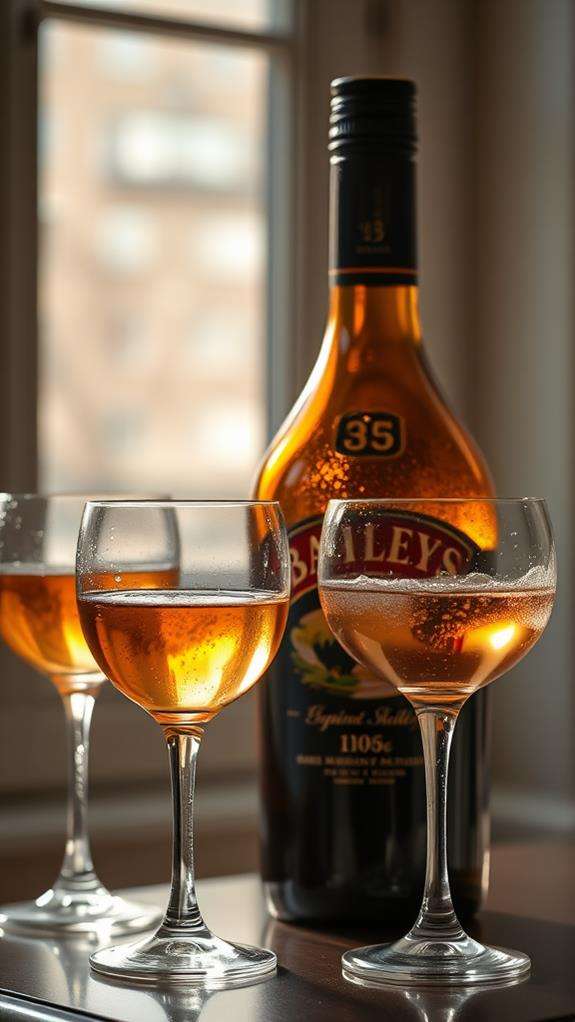
For the best drinking experience, you'll want to consume your opened bottle of Baileys within 6 months, which is when the Irish cream maintains its peak flavors and signature silky texture. While the liqueur remains safe to drink for up to 2 years after opening if properly stored, you might notice subtle changes in taste and consistency after the 6-month mark. To maximize your enjoyment, try tracking the opening date on the bottle and plan to finish it within that ideal 6-month window, especially if you're using it for cocktails or coffee drinks where fresh flavor is essential.
Peak Taste Period
Baileys Irish Cream maintains its ideal flavor profile for about 6 months after opening, though you'll want to consume it within this window to experience its richest taste. During this peak period, you'll notice the cream liqueur's signature blend of Irish whiskey, cream, and chocolate flavors at their most harmonious balance.
- The creamy texture remains perfectly smooth and velvety, without any separation or graininess
- The whiskey notes come through clean and crisp, complementing rather than overpowering the cream
- The chocolate and vanilla undertones present themselves clearly on both nose and palate
- The viscosity stays consistent, allowing for ideal pouring and mixing in cocktails
While your bottle will remain safe to drink for up to 2 years after opening, the first 6 months represent the golden window for best enjoyment. You'll find that the flavors are most vibrant and well-integrated during this time, especially if you've stored the bottle properly in a cool, dark place. Temperature fluctuations can accelerate flavor degradation, so consistent storage conditions help maintain that perfect balance of sweetness, creaminess, and alcoholic warmth that makes Baileys so enjoyable.
Storage Time Guidelines
Understanding the ideal storage timeline for your opened bottle helps guarantee the best drinking experience. You'll need to monitor different timeframes based on your storage conditions and the specific variety of Baileys you're consuming.
| Storage Condition | Recommended Timeline | Quality Impact |
|---|---|---|
| Room Temperature | 6 months maximum | Gradual flavor decline after 2 months |
| Refrigerated | Up to 24 months | Best taste maintained for 6 months |
| Extreme Heat | 2 months maximum | Rapid deterioration possible |
While Baileys contains preservatives that help maintain its shelf life, you shouldn't rely solely on the expiration date printed on the bottle once it's opened. The cream liqueur's quality begins to change as soon as it's exposed to air, though you won't notice immediate differences. You'll want to check for signs of separation, unusual thickness, or off-putting odors before consuming. If you're planning to store your opened Baileys for an extended period, refrigeration is your best option, as it notably slows down the degradation process and helps maintain the creamy texture you've come to expect.
Common Storage Mistakes
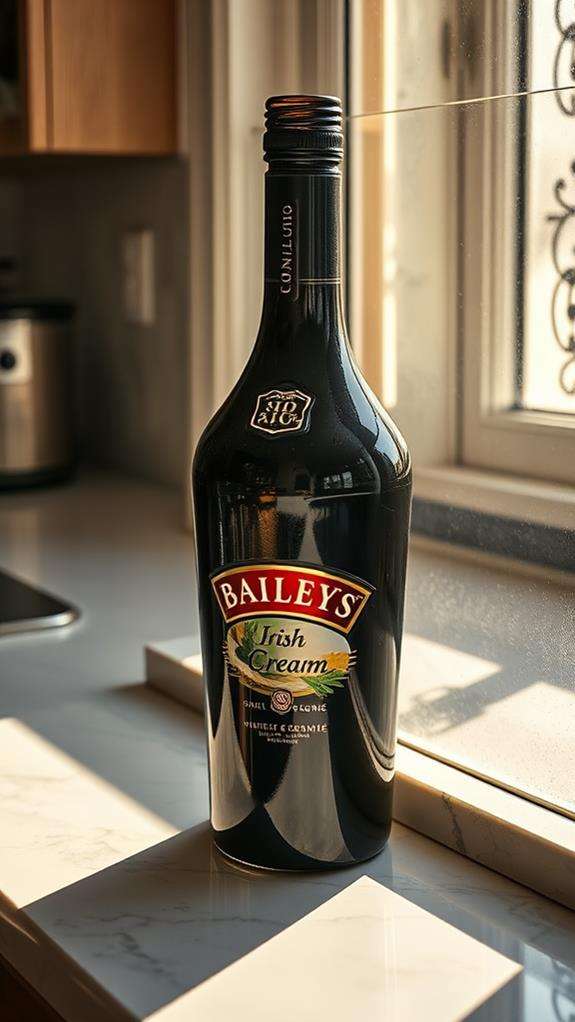
Several common mistakes can greatly reduce the shelf life of your opened Baileys Irish Cream. When you're not mindful of proper storage techniques, you'll likely find your favorite cream liqueur spoiling much faster than its expected shelf life of 24 months.
- Leaving the bottle in direct sunlight or near a window, which causes temperature fluctuations and accelerates degradation of the cream components
- Storing the bottle on its side, allowing the cream to constantly contact the cap area, leading to potential bacterial growth and seal deterioration
- Forgetting to tightly seal the cap after each use, which lets air enter and promotes oxidation while potentially introducing contaminants
- Keeping the bottle near heat sources like stoves or dishwashers, causing the cream to separate and potentially curdle
You'll want to avoid these storage pitfalls to maintain your Baileys' quality. Remember to keep the bottle upright in a cool, dark place, preferably in your refrigerator or a temperature-controlled cabinet. Every time you use your Baileys, make sure you're wiping the bottle's neck clean and securing the cap firmly. These simple preventive measures will help preserve your liqueur's signature taste and creamy texture.
Extending Your Baileys Lifespan

Smart storage habits can considerably extend your opened Baileys' lifespan beyond the typical 24-month window. To maximize your Irish cream's longevity, you'll want to implement several preservation techniques that protect its delicate cream and whiskey blend.
Store your Baileys upright in its original bottle, ensuring the cap is tightly sealed after each use to prevent oxidation. You'll get the best results by keeping it in a cool, dark place at a consistent temperature between 32-77°F (0-25°C). While refrigeration isn't mandatory, it can help maintain the cream's stability and prevent separation, especially if you live in a warm climate.
To further extend shelf life, avoid cross-contamination by using clean glasses and never pouring used Baileys back into the bottle. Consider transferring smaller amounts to a separate container for frequent use, keeping the main bottle sealed and undisturbed. You can also minimize exposure to air by using a vacuum wine stopper, which removes excess oxygen from the bottle. These methods, when combined with proper temperature control and handling, can help maintain your Baileys' quality for the full recommended storage period.
Alternative Storage Solutions

Creative storage alternatives can help preserve your opened Baileys when traditional methods aren't ideal. If you don't have room in your refrigerator or prefer to keep your bottle elsewhere, you'll want to explore these unconventional but effective storage solutions that maintain the liqueur's quality and extend its shelf life.
- Convert your Baileys into ice cube trays and freeze them for future use in cocktails or coffee drinks, allowing you to thaw only what you need
- Store the bottle in a wine cooler or beverage refrigerator set between 32-41°F (0-5°C), which provides ideal temperature control
- Use vacuum-sealed smaller containers to divide your Baileys into portion sizes, reducing exposure to air when serving
- Place the bottle in a dark, insulated beverage bag with ice packs for temporary storage during parties or events
When implementing these alternative storage methods, you'll need to monitor the temperature consistently and verify your containers are properly sealed. While these solutions might require initial setup, they're particularly useful when dealing with larger bottles or when you want to preserve smaller portions for longer periods. Remember to label your storage containers with the date you first opened the original bottle.
Safety and Consumption Tips
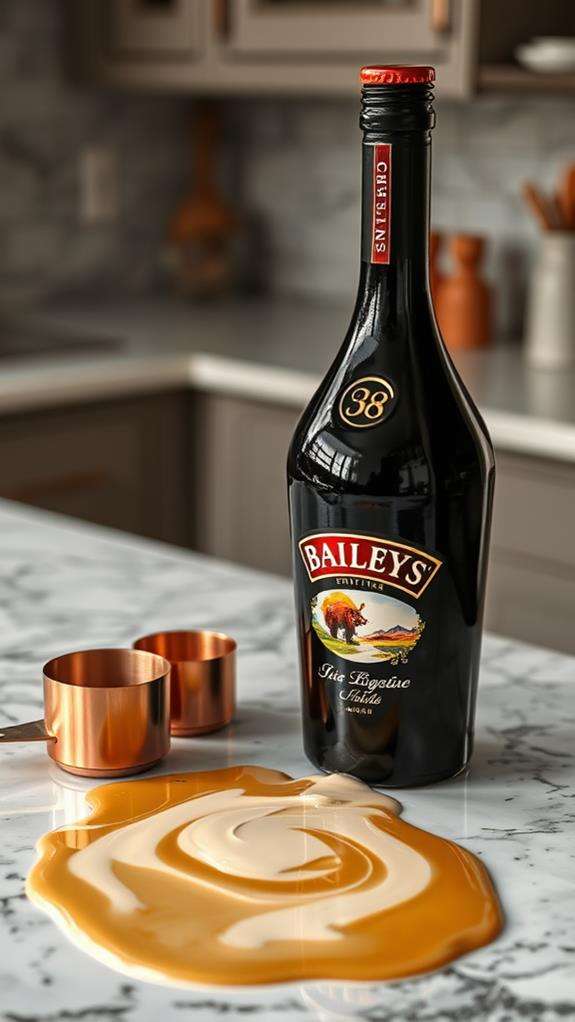
Keeping yourself safe while enjoying Baileys requires attention to both storage practices and consumption habits. You'll want to check for any signs of spoilage before each pour, including changes in texture, separation that won't remix, or unusual odors. If you notice any curdling or thickening, it's time to discard the bottle.
When serving Baileys, you shouldn't mix it with acidic ingredients like lime juice or cola, as these can cause the cream to curdle immediately. Always use clean glasses and measuring tools to prevent contamination, and don't leave your drink sitting out for extended periods. If you're hosting, pour servings as needed rather than leaving the bottle at room temperature.
You can maximize your safety by following the recommended two-hour rule: don't consume Baileys that's been left out beyond this timeframe. While the alcohol content provides some preservation, the dairy components remain vulnerable to bacterial growth. If you're uncertain about the liqueur's safety, trust your instincts and err on the side of caution. Remember to replace the cap tightly after each use to maintain freshness and prevent oxidation.
Frequently Asked Questions
Can Baileys Be Frozen to Make Alcoholic Ice Cream?
Yes, you can freeze Baileys to make alcoholic ice cream, but you'll need to follow specific steps due to alcohol's lower freezing point. You'll want to mix the Baileys with heavy cream, sugar, and vanilla extract to create a proper ice cream base. Since alcohol doesn't freeze completely, your ice cream will have a softer consistency than regular ice cream. For best results, use an ice cream maker and keep the Baileys content to about 3-4 tablespoons per pint.
Does Mixing Baileys With Hot Coffee Reduce Its Shelf Life?
Picture steam rising from your coffee as you pour in that creamy Baileys, creating a swirl of caramel colors. When you mix Baileys with hot coffee, you won't reduce its shelf life as long as you're drinking it right away. However, if you're saving the coffee-Baileys mixture for later, it's best to consume it within 24 hours. The heat won't immediately impact the cream liqueur, but letting the mixture sit can affect its quality.
Will Adding Baileys to Baking Recipes Affect Its Alcohol Content?
When you bake with Baileys, the alcohol content will decrease due to evaporation during the cooking process. At temperatures above 173°F (78.5°C), alcohol begins to evaporate, but the exact amount that remains depends on your cooking method and time. You'll retain about 25% of the alcohol after an hour of baking, while quick-cooking methods like flambéing will preserve up to 75%. The cream and flavors will stay intact regardless.
Can You Mix Different Flavors of Baileys in the Same Bottle?
You can technically mix different Baileys flavors in the same bottle, but it's not recommended for several reasons. First, you'll lose track of each flavor's expiration date. Second, the flavors might not blend well together, potentially creating an unbalanced taste. If you want to experiment with mixing flavors, it's better to blend them in individual serving glasses where you can control the proportions and avoid compromising the entire bottles.
Does Baileys Contain Lactose, and Does It Affect Storage Requirements?
"What you don't know can hurt you" – especially when it comes to lactose in your drinks. Yes, Baileys contains lactose since it's made with real cream, which can affect both you and its storage. You'll need to keep it refrigerated after opening because of the dairy content. If you're lactose intolerant, you'll want to be cautious with Baileys. The lactose content also means you should store it between 32-77°F for ideal freshness.





